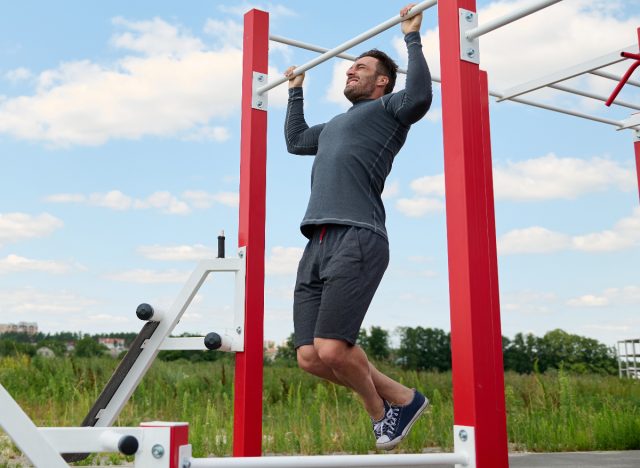If You Can Do This Many Pull-Ups, You Have Excellent Upper-Body Strength

Pull-ups have long been hailed as the ultimate test of upper-body strength and endurance. Unlike other exercises, which often rely on machines or external weights, pull-ups are the gold standard for assessing your ability to lift and control your own body. They challenge multiple muscle groups at once, making them a full-body effort. If you're wondering how many pull-ups signal excellent upper-body strength, I'm here to break it down.
Remember those dreaded pull-up tests back in elementary school P.E.? You'd hang there, praying to make it to at least one rep while your classmates watched from the sidelines—talk about pressure! But now, as an adult, mastering pull-ups is no longer about impressing your P.E. teacher—it's about building real, functional strength.
The beauty of the pull-up lies in how it recruits so many muscles. While the lats are the primary movers, your biceps, traps, shoulders, and core play a part. As you pull yourself up, you're engaging your back and arms while stabilizing through your core to avoid swinging. That means pull-ups test strength and measure your body's ability to work in coordination, endurance, and control.
In this article, I'll explain what makes the perfect pull-up, how many reps are considered excellent for different fitness levels, and give you the best exercises to improve your pull-up strength. Plus, I'll help you determine how often to test your pull-up ability to see how much you're improving. Whether you're just getting started or already smashing pull-up records, I have the best tips to help you level up your performance.
In This Article:
- What Makes the Perfect Pull-Up?
- Best Exercises To Improve Your Pull-Up Strength and Endurance
- How Often Should You Test Your Pull-Up Ability?
What Makes the Perfect Pull-Up?

A perfect pull-up isn't just about getting your chin above the bar—it's about mastering the movement with strength and control. I'm talking about straight arms at the bottom and controlled reps.
- Start with a full hang: Begin from a dead hang, arms fully extended, and shoulders relaxed.
- Engage your core: Avoid swinging or kipping by keeping your torso tight and controlled.
- Pull through your lats: As you pull, focus on squeezing your shoulder blades down and together.
- Reach a full range of motion: Your chin should clear the bar, but don't stop there—control the descent to return to a dead hang. A solid stretch of the lats is ideal for building pulling strength and muscle size!
Perfect form ensures you build strength efficiently while protecting your joints and muscles from injury.
How Many Pull-Ups Signal Excellent Upper-Body Strength?

Pull-ups are a powerful indicator of upper-body strength and endurance. The more reps you can perform, the stronger your back, arms, and core will be. Here's what's considered excellent:
- Men:
- Beginner: 1-4 reps
- Average: 8-12 reps
- Excellent: 15+ reps
- Women:
- Beginner: 1-2 reps
- Average: 4-8 reps
- Excellent: 10+ reps
These benchmarks vary depending on age, training experience, and body composition. But if you're hitting those higher numbers, you're well on mastering upper-body strength. Remember that pull-ups are not just about endurance; they also reflect muscle coordination and power.
Achieving the level of excellent pull-up performance means your back, biceps, forearms, and core are all firing on all cylinders. So, if you can hit 15+ pull-ups, you've earned the "excellent" label!
Best Exercises To Improve Your Pull-Up Strength and Endurance
If you want to crank out more pull-ups, these five exercises are non-negotiable in your training arsenal. Aim for 10-20 total sets per week to maximize progress, prioritizing back strength and a mix of pulling variations. Incorporate vertical pulls (pull-ups, lat pulldowns) and horizontal pulls (rows) to develop well-rounded pulling power and improve your overall performance.
1. Eccentric Pull-Ups
- Why: Eccentrics (lowering phase) build strength in the muscles you need to pull yourself up by focusing on controlled descents. This is especially helpful if you can't perform a full pull-up yet.
- How: Jump or step to the top (chin above the bar). Slowly lower yourself in 3-5 seconds back to a dead hang.
- Sets and Reps: 3-5 sets of 4-6 controlled reps.
2. Lat Pulldown
- Why: Lat pulldowns mimic the pulling motion of a pull-up and help you strengthen your lats and upper back.
- How: Sit at the machine, grip the bar slightly wider than shoulder-width, and pull it to your chest while keeping your back straight.
- Sets and Reps: 3-4 sets of 8-12 reps.
3. Single-Arm Dumbbell Row
- Why: Rows target the lats and build pulling strength, essential for improving your pull-ups.
- How: Place one knee and hand on a bench, grip a dumbbell with the opposite hand, and pull it toward your hip. Focus on squeezing your shoulder blade.
- Sets and Reps: 3-4 sets of 10-12 reps per side.
4. Dead Hangs
- Why: Dead hangs enhance grip strength and prepare your shoulders and lats for the demands of pull-ups.
- How: Hang onto a pull-up bar with a shoulder-width grip, keeping your shoulders engaged but relaxed.
- Sets and Reps: Hold for 20-40 seconds, 3-4 sets.
5. Assisted Pull-Ups
- Why: Assisted pull-ups allow you to practice the full range of motion with reduced resistance, helping you build strength and confidence.
- How: Use a resistance band or an assisted pull-up machine. Pull yourself up while maintaining proper form.
- Sets and Reps: 3-4 sets of 6-8 reps.
How Often Should You Test Your Pull-Up Ability?

Aim to test every 4-6 weeks. Use the time between tests to focus on strength-building exercises, rest adequately, and track your progress. Testing your pull-ups too often can lead to overtraining, especially if you're still building strength.
When testing, ensure you're well-rested and warmed up. Testing under ideal conditions will give you the most accurate reflection of your strength and allow you to adjust your training plan for continued improvement.









